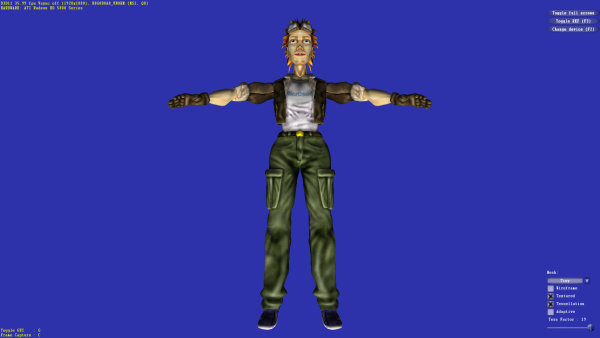 |
||
|
||
| ||
Direct3D 11: tesselationTesselation is rightfully the key innovation of Direct3D 11. There are several methods, including phong tessellation, PN triangles, Catmull-Clark subdivision. Tesselation is already used in DirectX 11 games like S.T.A.L.K.E.R.: Call of Prypyat, Colin McRae: Dirt 2, Alien vs. Predator, Metro 2033. In some of those tesselation is used in character models (all first-person shooters of the above), while in some tesselation is used to imitate realistic water surface (DiRT 2). Note that S.T.A.L.K.E.R.: Call of Prypyat uses PN Triangles, while Metro 2033 uses Phong tessellation. Our first tesselation test will be Detail Tessellation from ATI Radeon SDK. Essentially, it demonstrates both tesselation about two different bump mapping techniques: normal maps and parallax occlusion mapping.  As you can see, both GeForce GTX 480 and Radeon HD 5870 are less efficient in parallax occlusion mapping (medium columns on the diagram) than in tesselation (bottom columns). In other words, geometry imitated by computed pixels is slower than real geometry rendered by tesselation. This indicates that tesselation has better prospects where parallax mapping is currently used. Speaking of speed, Radeon HD 5970 naturally outperforms single-GPU cards. And GeForce GTX 480 outperforms Radeon HD 5870 by 5%-15%. The difference is bigger when tesselation is enabled. This corresponds to our expectations: the difference between GeForce GTX 480 and Radeon HD 5870 should be smaller in DX9/DX10 games and bigger in DX11 games that use tesselation. The second tesselation test is PN Triangles, yet another sample from the ATI Radeon SDK. Actually, this and the previous sample are also found in the DirectX SDK, so many game developers are likely to use them in their games. Anyway, we examined this test with different tessellation factors to see what effect it has on general performance.  It seems this test is the first to show th real geometry power of GF100. Yes, it's only a synthetic test, and such extreme tessellation factors will hardly be soon. But that's why we need synthetics -- to estimate the prospects of graphics cards in future tasks. GeForce GTX 480 shows what GF100 is capable of when tesselation is involved. Its only GPU outperforms Radeon HD 5970 by about 4 times. As for Radeon HD 5870, it's simply annihilated. Essentially, GF100 can use tesselation factors a few steps higher than those available to RV870. But let's examine another test -- NVIDIA Realistic Water Terrain -- also known as the Island demo. This one was developed by Timofey Cheblokov aka Smalltim. This demo uses tesselation and displacement mapping to render realistic water and terrain. Boy, does it look nice.  Actually, Island isn't a purely tesselation test, it features quite complex pixel and compute shaders, so the difference in performance can be smaller than in the previous test. On the other hand, the results are closer to real applications. We tested the demo with 4 tesselation factors -- Dynamic Tessellation LOD. With the lowest factor GeForce GTX 480 just slightly outperforms Radeon HD 5870 and yields to Radeon HD 5970. But as the factor and scene complexity increase, the performance of GeForce GTX 480 doesn't drop as much as that of its rivals. As you can see, GeForce GTX 480 performs with the LOD of 100 like Radeon HD 5870 does with the LOD of 25. Meaning it processes 28M triangles at the speed Radeon HD 5870 handles 4M triangles. This is a very big difference. Conclusions on synthetic testsJudging by the synthetic test results, we can say that NVIDIA's new architecture is quite powerful and more feature-rich. Graphics cards based on GF100 are among the fastest single-GPU solutions available. The increased number of geometry units and their parallelized operation boost tesselation and geometry shaders performance. The novelty is unsurpassed in synthetic tesselation tests -- even Radeon HD 5970 yields, not to mention Radeon HD 5870 that is outperformed by 4-6 times. This won't change until AMD rolls out its own architecture tailored to geometry processing. Speaking of non-tesselation tests, the situation in actual games will be similar to what we've seen in our synthetics -- in some cases GeForce GTX 480 will be the leader, in other cases it will lose to its rival. However, it shouldn't lose much, because there are no games that are solely limited to pure math or texture fetches -- two things GF100 doesn't do as good. Anyway, it seems that GF100 has become closer to CPU, more universal (remember its C++ support and caching). However, it still yields to RV870 in terms of pure computing power. The relatively low peak computing and texture performance makes GeForce GTX 480 lose to its competitor in a number of tests, but the general performance of GeForce GTX 480 is still quite decent. This should also be confirmed by our gaming tests. We believe gaming test results will be close to what we've seen in synthetic tests. Do not expect a big difference in performance, because in actual games rendering speed often depends on several factors, including fillrate and memory bandwidth -- two things synthetic tests are less sensitive to. GeForce GTX 480 will probably outperform Radeon HD 5870 slightly in non-tesselation games, and will definitely show better results in titles that use tesselation. Write a comment below. No registration needed!
|
Platform · Video · Multimedia · Mobile · Other || About us & Privacy policy · Twitter · Facebook Copyright © Byrds Research & Publishing, Ltd., 1997–2011. All rights reserved. |